Profile

|
Dr. Tim Gerrits |
Publications
Interactive Streaming of 3D Scenes to Mobile Devices using Dual-Layer Image Warping and Loop-based Depth Reconstruction
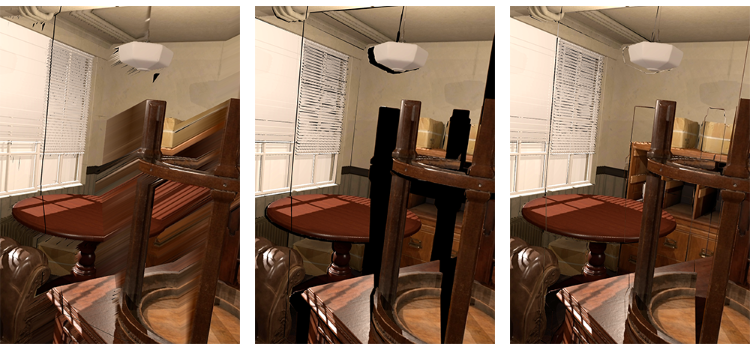
While mobile devices have developed into hardware with advanced capabilities for rendering 3D gra-phics, they commonly lack the computational power to render large 3D scenes with complex lighting interactively. A prominent approach to tackle this is rendering required views on a remote server and streaming them to the mobile client. However, the rate at which servers can supply data is limited, e.g., by the available network speed, requiring image-based rendering techniques like image warping to compensate for the latency and allow a smooth user experience, especially in scenes where rapid user movement is essential. In this paper, we present a novel streaming approach designed to minimize arti-facts during the warping process by including an additional visibility layer that keeps track of occluded surfaces while allowing access to 360° views. In addition, we propose a novel mesh generation techni-que based on the detection of loops to reliably create a mesh that encodes the depth information requi-red for the image warping process. We demonstrate our approach in a number of complex scenes and compare it against existing works using two layers and one layer alone. The results indicate a significant reduction in computation time while achieving comparable or even better visual results when using our dual-layer approach.
@ARTICLE{Koenen-2025-A05,
author={Koenen,J. and Oehrl,S. and Kuhlen,T. and Gerrits,T.},
title={Interactive Streaming of 3D Scenes to Mobile Devices using Dual-Layer Image Warping and Loop-based Depth Reconstruction},
journal={Journal of WSCG},
year={2025},
volume={33},
number = {1},
pages={1-10},
doi={10.24132/JWSCG.2025-1},
publisher={Union Agency, Science Press},
issn={1213-6972},
document_type={Article},
}
Exploring Uncertainty Visualization for Degenerate Tensors in 3D Symmetric Second-Order Tensor Field Ensembles

second-order tensors are fundamental in various scientific and engineering domains, as they can represent properties such as material stresses or diffusion processes in brain tissue. In recent years, several approaches have been introduced and improved to analyze these fields using topological features, such as degenerate tensor locations, i.e., the tensor has repeated eigenvalues, or normal surfaces. Traditionally, the identification of such features has been limited to single tensor fields. However, it has become common to create ensembles to account for uncertainties and variability in simulations and measurements. In this work, we explore novel methods for describing and visualizing degenerate tensor locations in 3D symmetric second-order tensor field ensembles. We base our considerations on the tensor mode and analyze its practicality in characterizing the uncertainty of degenerate tensor locations before proposing a variety of visualization strategies to effectively communicate degenerate tensor information. We demonstrate our techniques for synthetic and simulation data sets. The results indicate that the interplay of different descriptions for uncertainty can effectively convey information on degenerate tensor locations.
Best Paper Award!@INPROCEEDINGS{10771098,
author={Koenen, Jens and Petersen, Marvin and Garth, Christoph and Gerrits, Tim},
booktitle={2024 IEEE Visualization and Visual Analytics (VIS)},
title={DaVE - A Curated Database of Visualization Examples},
year={2024},
volume={},
number={},
pages={11-15},
keywords={Codes;Visual analytics;High performance computing;Data visualization;Containers;Visual databases;Visualization;Curated Database;High-Performance Computing},
doi={10.1109/VIS55277.2024.00010}
}
InsitUE - Enabling Hybrid In-situ Visualizations through Unreal Engine and Catalyst
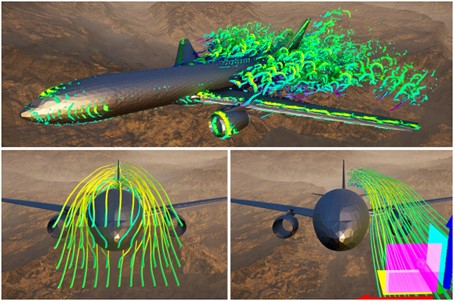
In-situ, in-transit, and hybrid approaches have become well-established visualization methods over the last decades. Especially for large simulations, these paradigms enable visualization and additionally allow for early insights. While there has been a lot of research on combining these approaches with classical visualization software, only a few worked on combining in-situ/in-transit approaches with modern game engines. In this paper, we present and demonstrate InsitUE, a Catalyst2 compatible hybrid workflow that enables interactive real-time visualization of simulation results using Unreal Engine.
@InProceedings{10.1007/978-3-031-73716-9_33,
author="Kr{\"u}ger, Marcel
and Milke, Jan Frieder
and Kuhlen, Torsten W.
and Gerrits, Tim",
editor="Weiland, Mich{\`e}le
and Neuwirth, Sarah
and Kruse, Carola
and Weinzierl, Tobias",
title="InsitUE - Enabling Hybrid In-situ Visualizations Through Unreal Engine and Catalyst",
booktitle="High Performance Computing. ISC High Performance 2024 International Workshops",
year="2025",
publisher="Springer Nature Switzerland",
address="Cham",
pages="469--481",
abstract="In-situ, in-transit, and hybrid approaches have become well-established visualization methods over the last decades. Especially for large simulations, these paradigms enable visualization and additionally allow for early insights. While there has been a lot of research on combining these approaches with classical visualization software, only a few worked on combining in-situ/in-transit approaches with modern game engines. In this paper, we present and demonstrate InsitUE, a Catalyst2 compatible hybrid workflow that enables interactive real-time visualization of simulation results using Unreal Engine.",
isbn="978-3-031-73716-9"
}
DaVE - A Curated Database of Visualization Examples
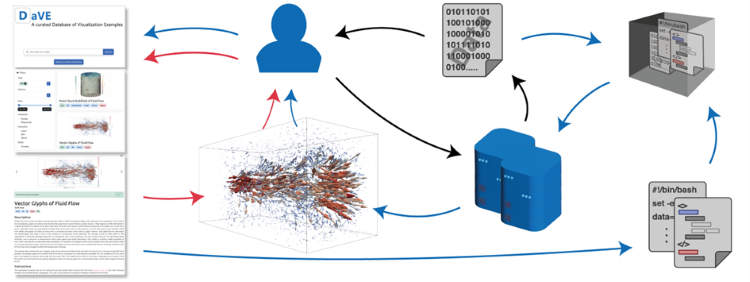
Visualization, from simple line plots to complex high-dimensional visual analysis systems, has established itself throughout numerous domains to explore, analyze, and evaluate data. Applying such visualizations in the context of simulation science where High-Performance Computing (HPC) produces ever-growing amounts of data that is more complex, potentially multidimensional, and multimodal, takes up resources and a high level of technological experience often not available to domain experts. In this work, we present DaVE -- a curated database of visualization examples, which aims to provide state-of-the-art and advanced visualization methods that arise in the context of HPC applications. Based on domain- or data-specific descriptors entered by the user, DaVE provides a list of appropriate visualization techniques, each accompanied by descriptions, examples, references, and resources. Sample code, adaptable container templates, and recipes for easy integration in HPC applications can be downloaded for easy access to high-fidelity visualizations. While the database is currently filled with a limited number of entries based on a broad evaluation of needs and challenges of current HPC users, DaVE is designed to be easily extended by experts from both the visualization and HPC communities.
@inproceedings{dave2024,
author={Koenen, Jens and Petersen, Marvin and Garth, Christoph and Gerrits, Tim},
booktitle={2024 IEEE Visualization and Visual Analytics (VIS)},
title={DaVE - A Curated Database of Visualization Examples},
year={2024},
month={Oct},
volume={},
number={},
pages={11-15},
keywords={Codes;Visual analytics;High performance computing;Data visualization;Containers;Visual databases;Visualization;Curated Database;High-Performance Computing},
doi={10.1109/VIS55277.2024.00010},
ISSN={2771-9553}
}
Region-based Visualization in Hierarchically Clustered Ensemble Volumes
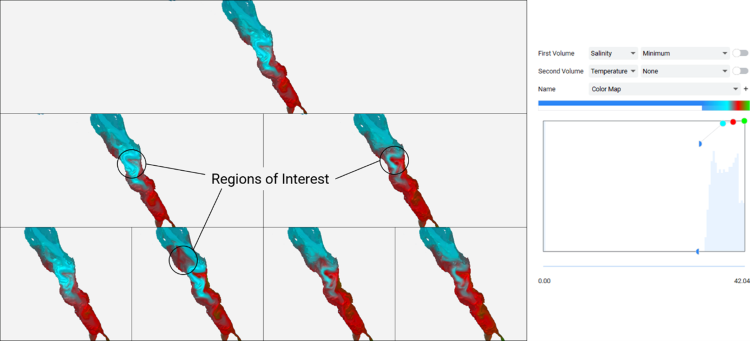
Ensembles of simulations are generated to capture uncertainties in the simulation model and its initialization. When simulating 3D spatial phenomena, the value distributions may vary from region to region. Therefore, visualization methods need to adapt to different types and shapes of statistical distributions across regions. In the case of normal distribution, a region is well represented and visualized by the means and standard deviations. In the case of multi-modal distributions, the ensemble can be subdivided to investigate whether sub-ensembles exhibit uni-modal distributions in that region. We, therefore, propose an interactive visual analysis approach for region-based visualization within a hierarchy of sub-ensembles. The hierarchy of sub-ensembles is created using hierarchical clustering, while regions can be defined using parallel coordinates of statistical properties. The identified regions are rendered in a hierarchy of interactive volume renderers. We apply our approach to two real-world simulation ensembles to show its usability.
@inproceedings{10.2312:vmv.20241206,
booktitle = {Vision, Modeling, and Visualization},
editor = {Linsen, Lars and Thies, Justus},
title = {{Region-based Visualization in Hierarchically Clustered Ensemble Volumes}},
author = {Rave, Hennes and Evers, Marina and Gerrits, Tim and Linsen, Lars},
year = {2024},
publisher = {The Eurographics Association},
ISBN = {978-3-03868-247-9},
DOI = {10.2312/vmv.20241206}
}
IntenSelect+: Enhancing Score-Based Selection in Virtual Reality

Object selection in virtual environments is one of the most common and recurring interaction tasks. Therefore, the used technique can critically influence a system’s overall efficiency and usability. IntenSelect is a scoring-based selection-by-volume technique that was shown to offer improved selection performance over conventional raycasting in virtual reality. This initial method, however, is most pronounced for small spherical objects that converge to a point-like appearance only, is challenging to parameterize, and has inherent limitations in terms of flexibility. We present an enhanced version of IntenSelect called IntenSelect+ designed to overcome multiple shortcomings of the original IntenSelect approach. In an empirical within-subjects user study with 42 participants, we compared IntenSelect+ to IntenSelect and conventional raycasting on various complex object configurations motivated by prior work. In addition to replicating the previously shown benefits of IntenSelect over raycasting, our results demonstrate significant advantages of IntenSelect+ over IntenSelect regarding selection performance, task load, and user experience. We, therefore, conclude that IntenSelect+ is a promising enhancement of the original approach that enables faster, more precise, and more comfortable object selection in immersive virtual environments.
» Show BibTeX
@ARTICLE{10459000,
author={Krüger, Marcel and Gerrits, Tim and Römer, Timon and Kuhlen, Torsten and Weissker, Tim},
journal={IEEE Transactions on Visualization and Computer Graphics},
title={IntenSelect+: Enhancing Score-Based Selection in Virtual Reality},
year={2024},
volume={},
number={},
pages={1-10},
keywords={Visualization;Three-dimensional displays;Task analysis;Usability;Virtual environments;Shape;Engines;Virtual Reality;3D User Interfaces;3D Interaction;Selection;Score-Based Selection;Temporal Selection;IntenSelect},
Game Engines for Immersive Visualization: Using Unreal Engine Beyond Entertainment
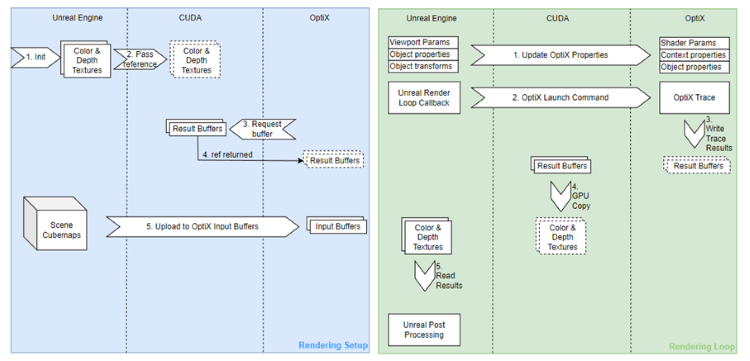
One core aspect of immersive visualization labs is to develop and provide powerful tools and applications that allow for efficient analysis and exploration of scientific data. As the requirements for such applications are often diverse and complex, the same applies to the development process. This has led to a myriad of different tools, frameworks, and approaches that grew and developed over time. The steady advance of commercial off-the-shelf game engines such as Unreal Engine has made them a valuable option for development in immersive visualization labs. In this work, we share our experience of migrating to Unreal Engine as a primary developing environment for immersive visualization applications. We share our considerations on requirements, present use cases developed in our lab to communicate advantages and challenges experienced, discuss implications on our research and development environments, and aim to provide guidance for others within our community facing similar challenges.
@article{10.1162/pres_a_00416,
author = {Krüger, Marcel and Gilbert, David and Kuhlen, Torsten W. and Gerrits, Tim},
title = "{Game Engines for Immersive Visualization: Using Unreal Engine Beyond Entertainment}",
journal = {PRESENCE: Virtual and Augmented Reality},
volume = {33},
pages = {31-55},
year = {2024},
month = {07},
abstract = "{One core aspect of immersive visualization labs is to develop and provide powerful tools and applications that allow for efficient analysis and exploration of scientific data. As the requirements for such applications are often diverse and complex, the same applies to the development process. This has led to a myriad of different tools, frameworks, and approaches that grew and developed over time. The steady advance of commercial off-the-shelf game engines such as Unreal Engine has made them a valuable option for development in immersive visualization labs. In this work, we share our experience of migrating to Unreal Engine as a primary developing environment for immersive visualization applications. We share our considerations on requirements, present use cases developed in our lab to communicate advantages and challenges experienced, discuss implications on our research and development environments, and aim to provide guidance for others within our community facing similar challenges.}",
issn = {1054-7460},
doi = {10.1162/pres_a_00416},
url = {https://doi.org/10.1162/pres\_a\_00416},
eprint = {https://direct.mit.edu/pvar/article-pdf/doi/10.1162/pres\_a\_00416/2465397/pres\_a\_00416.pdf},
}
On the Computation of User Placements for Virtual Formation Adjustments during Group Navigation
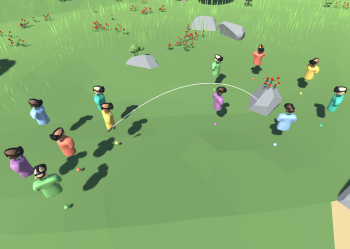
Several group navigation techniques enable a single navigator to control travel for all group members simultaneously in social virtual reality. A key aspect of this process is the ability to rearrange the group into a new formation to facilitate the joint observation of the scene or to avoid obstacles on the way. However, the question of how users should be distributed within the new formation to create an intuitive transition that minimizes disruptions of ongoing social activities is currently not explored. In this paper, we begin to close this gap by introducing four user placement strategies based on mathematical considerations, discussing their benefits and drawbacks, and sketching further novel ideas to approach this topic from different angles in future work. Our work, therefore, contributes to the overarching goal of making group interactions in social virtual reality more intuitive and comfortable for the involved users.
» Show BibTeX
@INPROCEEDINGS{10536250,
author={Weissker, Tim and Franzgrote, Matthis and Kuhlen, Torsten and Gerrits, Tim},
booktitle={2024 IEEE Conference on Virtual Reality and 3D User Interfaces Abstracts and Workshops (VRW)},
title={On the Computation of User Placements for Virtual Formation Adjustments During Group Navigation},
year={2024},
volume={},
number={},
pages={396-402},
keywords={Three-dimensional displays;Navigation;Conferences;Virtual reality;Human factors;User interfaces;Task analysis;Human-centered computing—Human computer interaction (HCI)—Interaction paradigms—Virtual reality;Human-centered computing—Interaction design—Interaction design theory, concepts and paradigms},
doi={10.1109/VRW62533.2024.00077}}
Leveraging BC6H Texture Compression and Filtering for Efficient Vector Field Visualization
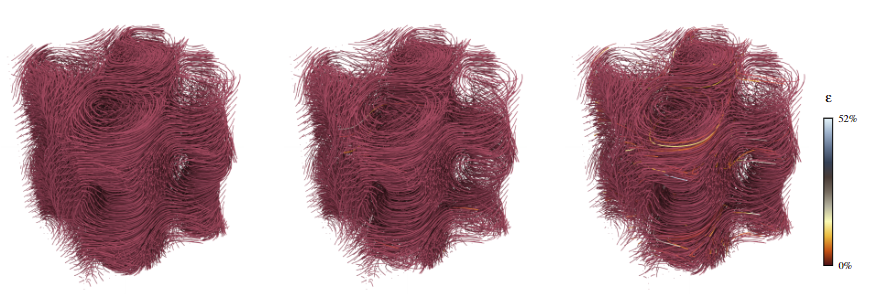
The steady advance of compute hardware is accompanied by an ever-steeper amount of data to be processed for visualization. Limited memory bandwidth provides a significant bottleneck to the runtime performance of visualization algorithms while limited video memory requires complex out-of-core loading techniques for rendering large datasets. Data compression methods aim to overcome these limitations, potentially at the cost of information loss. This work presents an approach to the compression of large data for flow visualization using the BC6H texture compression format natively supported, and therefore effortlessly leverageable, on modern GPUs. We assess the performance and accuracy of BC6H for compression of steady and unsteady vector fields and investigate its applicability to particle advection. The results indicate an improvement in memory utilization as well as runtime performance, at a cost of moderate loss in precision.
@inproceedings{10.2312:vmv.20231238,
booktitle = {Vision, Modeling, and Visualization},
editor = {Guthe, Michael and Grosch, Thorsten},
title = {{Leveraging BC6H Texture Compression and Filtering for Efficient Vector Field Visualization}},
author = {Oehrl, Simon and Milke, Jan Frieder and Koenen, Jens and Kuhlen, Torsten W. and Gerrits, Tim},
year = {2023},
publisher = {The Eurographics Association},
ISBN = {978-3-03868-232-5},
DOI = {10.2312/vmv.20231238}
}
Poster: DaVE - A curated Database of Visualization Examples

Visualization is used throughout all scientific domains for efficient analysis of data and experiments. Learning, underestanding, implementing, and applying suitable, state-of-the-art visualization techniques in HPC projects takes time and and a high level of technological ability and experience. DaVE sets out to offer a user-friendly resource with detailed descriptions, samples, and HPC-specific implementations of visualization methods. It simplifies method discovery with tags and encourages collaboration to foster a platform for sharing best practices and staying updated thus filling a crucial gap in the HPC community by providing a central resource for advanced visualization.
@misc{tim_gerrits_2023_8381126,
author = {Tim Gerrits and
Christoph Garth},
title = {{DaVE - A curated Database of Visualization
Examples}},
month = sep,
year = 2023,
publisher = {Zenodo},
doi = {10.5281/zenodo.8381126},
url = {https://doi.org/10.5281/zenodo.8381126}
}
A Case Study on Providing Accessibility-Focused In-Transit Architectures for Neural Network Simulation and Analysis
Due to the ever-increasing availability of high-performance computing infrastructure, developers can simulate increasingly complex models. However, the increased complexity comes with new challenges regarding data processing and visualization due to the sheer size of simulations. Exploring simulation results needs to be handled efficiently via in-situ/in-transit analysis during run-time. However, most existing in-transit solutions require sophisticated and prior knowledge and significant alteration to existing simulation and visualization code, which produces a high entry barrier for many projects. In this work, we report how Insite, a lightweight in-transit pipeline, provided in-transit visualization and computation capability to various research applications in the neuronal network simulation domain. We describe the development process, including feedback from developers and domain experts, and discuss implications.
@inproceedings{kruger2023case,
title={A Case Study on Providing Accessibility-Focused In-Transit Architectures for Neural Network Simulation and Analysis},
author={Kr{\"u}ger, Marcel and Oehrl, Simon and Kuhlen, Torsten Wolfgang and Gerrits, Tim},
booktitle={International Conference on High Performance Computing},
pages={277--287},
year={2023},
organization={Springer}
}
A Case Study on Providing Immersive Visualization for Neuronal Network Data Using COTS Soft- and Hardware

COTS VR hardware and modern game engines create the impression that bringing even complex data into VR has become easy. In this work, we investigate to what extent game engines can support the development of immersive visualization software with a case study. We discuss how the engine can support the development and where it falls short, e.g., failing to provide acceptable rendering performance for medium and large-sized data sets without using more sophisticated features.
@INPROCEEDINGS{10108843,
author={Krüger, Marcel and Li, Qin and Kuhlen, Torsten W. and Gerrits, Tim},
booktitle={2023 IEEE Conference on Virtual Reality and 3D User Interfaces Abstracts and Workshops (VRW)},
title={A Case Study on Providing Immersive Visualization for Neuronal Network Data Using COTS Soft- and Hardware},
year={2023},
volume={},
number={},
pages={201-205},
doi={10.1109/VRW58643.2023.00050}}
IEEE SciVis Contest 2023 - Dataset of Neuronal Network Simulations of the Human Brain
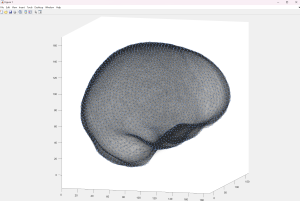
The IEEE SciVis Contest is held annually as part of the IEEE VIS Conference. It challenges participants within the visualization community to create innovative and effective state-of-the-art visualizations to analyze and understand complex scientific data. In 2023, the data described neuronal network simulations of plasticity changes in the human brain provided by a collaboration of the Crosssectional Group Parallelism and Performance, and the Crosssectional Group Visualization within the National High Performance Computing Center for Computational Engineering Science (NHR4CES).
@dataset{gerrits_2024_10519411,
author = {Gerrits, Tim and
Czappa, Fabian and
Banesh, Divya and
Wolf, Felix},
title = {{IEEE SciVis Contest 2023 - Dataset of Neuronal
Network Simulations of the Human Brain}},
month = jan,
year = 2024,
publisher = {Zenodo},
version = {1.0},
doi = {10.5281/zenodo.10519411},
url = {https://doi.org/10.5281/zenodo.10519411}
}
Poster: Insite Pipeline - A Pipeline Enabling In-Transit Processing for Arbor, NEST and TVB
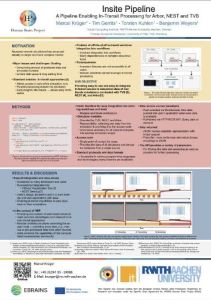
Simulation of neuronal networks has steadily advanced and now allows for larger and more complex models. However, scaling simulations to such sizes comes with issues and challenges.Especially the amount of data produced, as well as the runtime of the simulation, can be limiting.Often, storing all data on disk is impossible, and users might have to wait for a long time until they can process the data.A standard solution in simulation science is to use in-transit approaches.In-transit implementations allow users to access data while the simulation is still running and do parallel processing outside the simulation.This allows for early insights into the results, early stopping of simulations that are not promising, or even steering of the simulations.Existing in-transit solutions, however, are often complex to integrate into the workflow as they rely on integration into simulators and often use data formats that are complex to handle.This is especially constraining in the context of multi-disciplinary research conducted in the HBP, as such an important feature should be accessible to all users.
To remedy this, we developed Insite, a pipeline that allows easy in-transit access to simulation data of multiscale simulations conducted with TVB, NEST, and Arbor.
@misc{kruger_marcel_2023_7849225,
author = {Krüger, Marcel and
Gerrits, Tim and
Kuhlen, Torsten and
Weyers, Benjamin},
title = {{Insite Pipeline - A Pipeline Enabling In-Transit
Processing for Arbor, NEST and TVB}},
month = mar,
year = 2023,
publisher = {Zenodo},
doi = {10.5281/zenodo.7849225},
url = {https://doi.org/10.5281/zenodo.7849225}
}
Insite: A Pipeline Enabling In-Transit Visualization and Analysis for Neuronal Network Simulations

Neuronal network simulators are central to computational neuroscience, enabling the study of the nervous system through in-silico experiments. Through the utilization of high-performance computing resources, these simulators are capable of simulating increasingly complex and large networks of neurons today. Yet, the increased capabilities introduce a challenge to the analysis and visualization of the simulation results. In this work, we propose a pipeline for in-transit analysis and visualization of data produced by neuronal network simulators. The pipeline is able to couple with simulators, enabling querying, filtering, and merging data from multiple simulation instances. Additionally, the architecture allows user-defined plugins that perform analysis tasks in the pipeline. The pipeline applies traditional REST API paradigms and utilizes data formats such as JSON to provide easy access to the generated data for visualization and further processing. We present and assess the proposed architecture in the context of neuronal network simulations generated by the NEST simulator.
@InProceedings{10.1007/978-3-031-23220-6_20,
author="Kr{\"u}ger, Marcel and Oehrl, Simon and Demiralp, Ali C. and Spreizer, Sebastian and Bruchertseifer, Jens and Kuhlen, Torsten W. and Gerrits, Tim and Weyers, Benjamin",
editor="Anzt, Hartwig and Bienz, Amanda and Luszczek, Piotr and Baboulin, Marc",
title="Insite: A Pipeline Enabling In-Transit Visualization and Analysis for Neuronal Network Simulations",
booktitle="High Performance Computing. ISC High Performance 2022 International Workshops",
year="2022",
publisher="Springer International Publishing",
address="Cham",
pages="295--305",
isbn="978-3-031-23220-6"
}
Performance Assessment of Diffusive Load Balancing for Distributed Particle Advection
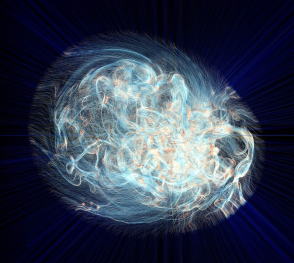
Particle advection is the approach for the extraction of integral curves from vector fields. Efficient parallelization of particle advection is a challenging task due to the problem of load imbalance, in which processes are assigned unequal workloads, causing some of them to idle as the others are performing computing. Various approaches to load balancing exist, yet they all involve trade-offs such as increased inter-process communication, or the need for central control structures. In this work, we present two local load balancing methods for particle advection based on the family of diffusive load balancing. Each process has access to the blocks of its neighboring processes, which enables dynamic sharing of the particles based on a metric defined by the workload of the neighborhood. The approaches are assessed in terms of strong and weak scaling as well as load imbalance. We show that the methods reduce the total run-time of advection and are promising with regard to scaling as they operate locally on isolated process neighborhoods.
Astray: A Performance-Portable Geodesic Ray Tracer

Geodesic ray tracing is the numerical method to compute the motion of matter and radiation in spacetime. It enables visualization of the geometry of spacetime and is an important tool to study the gravitational fields in the presence of astrophysical phenomena such as black holes. Although the method is largely established, solving the geodesic equation remains a computationally demanding task. In this work, we present Astray; a high-performance geodesic ray tracing library capable of running on a single or a cluster of computers equipped with compute or graphics processing units. The library is able to visualize any spacetime given its metric tensor and contains optimized implementations of a wide range of spacetimes, including commonly studied ones such as Schwarzschild and Kerr. The performance of the library is evaluated on standard consumer hardware as well as a compute cluster through strong and weak scaling benchmarks. The results indicate that the system is capable of reaching interactive frame rates with increasing use of high-performance computing resources. We further introduce a user interface capable of remote rendering on a cluster for interactive visualization of spacetimes.
@inproceedings {10.2312:vmv.20221208,
booktitle = {Vision, Modeling, and Visualization},
editor = {Bender, Jan and Botsch, Mario and Keim, Daniel A.},
title = {{Astray: A Performance-Portable Geodesic Ray Tracer}},
author = {Demiralp, Ali Can and Krüger, Marcel and Chao, Chu and Kuhlen, Torsten W. and Gerrits, Tim},
year = {2022},
publisher = {The Eurographics Association},
ISBN = {978-3-03868-189-2},
DOI = {10.2312/vmv.20221208}
}
Studying the Effect of Tissue Properties on Radiofrequency Ablation by Visual Simulation Ensemble Analysis
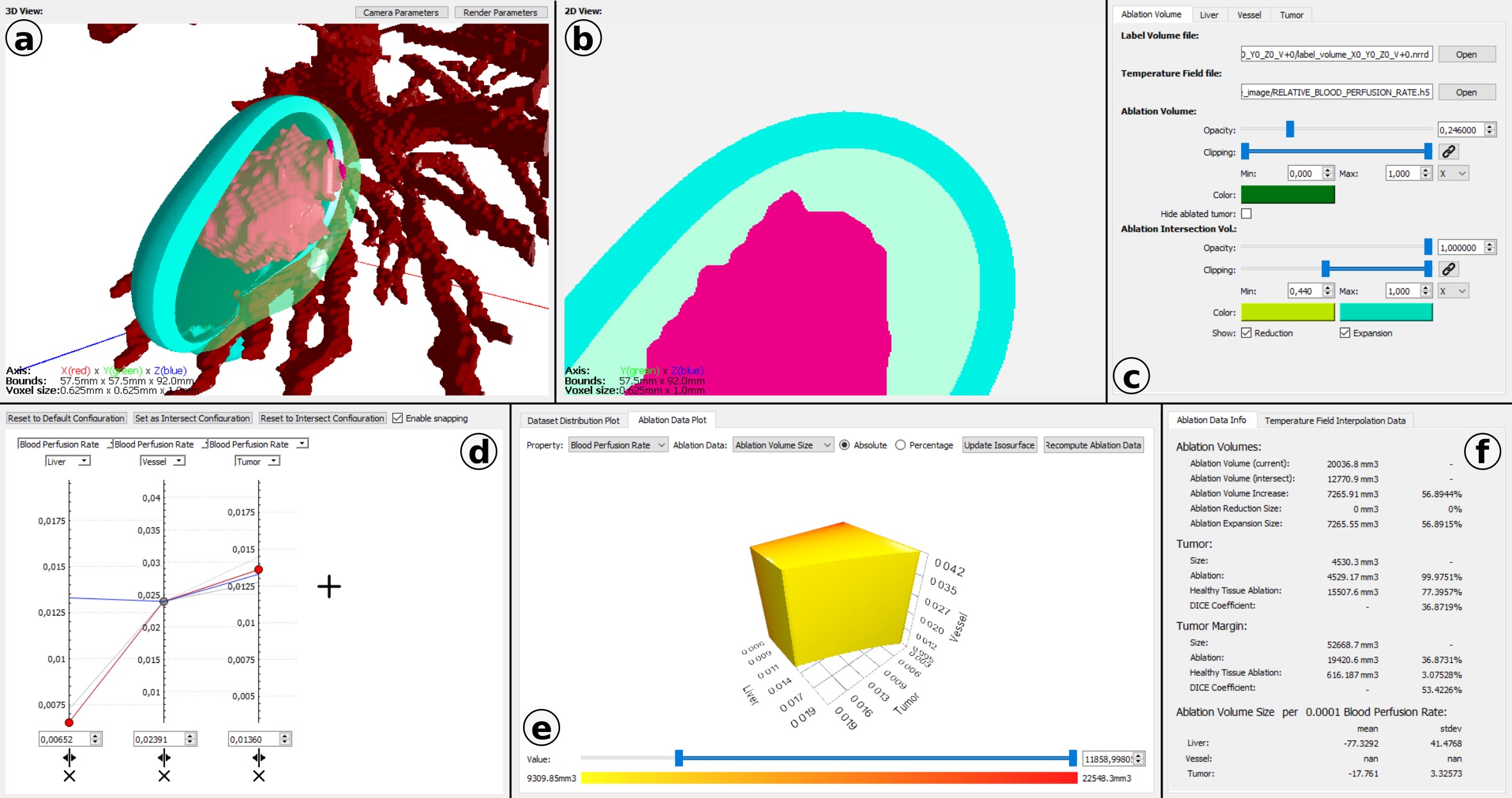
Radiofrequency ablation is a minimally invasive, needle-based medical treatment to ablate tumors by heating due to absorption of radiofrequency electromagnetic waves. To ensure the complete target volume is destroyed, radiofrequency ablation simulations are required for treatment planning. However, the choice of tissue properties used as parameters during simulation induce a high uncertainty, as the tissue properties are strongly patient-dependent. To capture this uncertainty, a simulation ensemble can be created. Understanding the dependency of the simulation outcome on the input parameters helps to create improved simulation ensembles by focusing on the main sources of uncertainty and, thus, reducing computation costs. We present an interactive visual analysis tool for radiofrequency ablation simulation ensembles to target this objective. Spatial 2D and 3D visualizations allow for the comparison of ablation results of individual simulation runs and for the quantification of differences. Simulation runs can be interactively selected based on a parallel coordinates visualization of the parameter space. A 3D parameter space visualization allows for the analysis of the ablation outcome when altering a selected tissue property for the three tissue types involved in the ablation process. We discuss our approach with domain experts working on the development of new simulation models and demonstrate the usefulness of our approach for analyzing the influence of different tissue properties on radiofrequency ablations.
Honorable Mention Award!@inproceedings {10.2312:vcbm.20221187,
booktitle = {Eurographics Workshop on Visual Computing for Biology and Medicine},
editor = {Renata G. Raidou and Björn Sommer and Torsten W. Kuhlen and Michael Krone and Thomas Schultz and Hsiang-Yun Wu},
title = {{Studying the Effect of Tissue Properties on Radiofrequency Ablation by Visual Simulation Ensemble Analysis}},
author = {Heimes, Karl and Evers, Marina and Gerrits, Tim and Gyawali, Sandeep and Sinden, David and Preusser, Tobias and Linsen, Lars},
year = {2022},
publisher = {The Eurographics Association},
ISSN = {2070-5786},
ISBN = {978-3-03868-177-9},
DOI = {10.2312/vcbm.20221187}
}
Multifaceted Visual Analysis of Oceanographic Simulation Ensemble Data
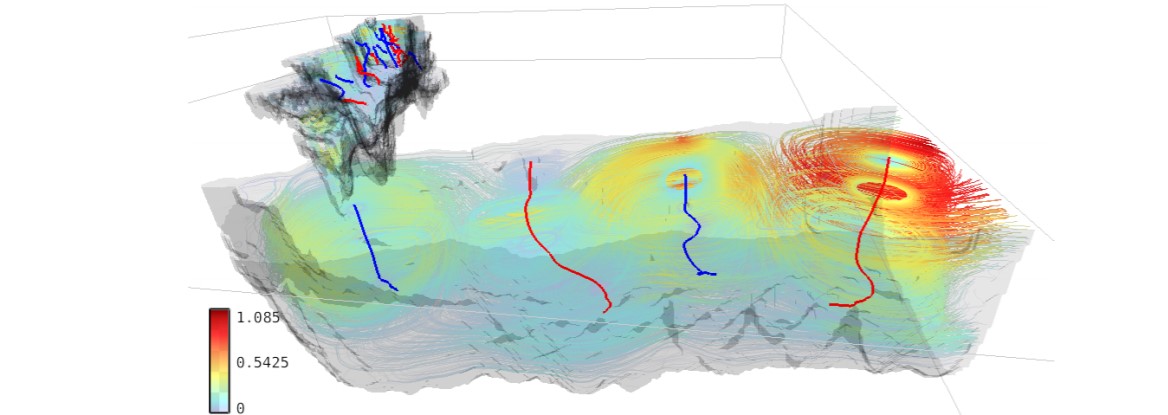
The analysis of multirun oceanographic simulation data imposes various challenges ranging from visualizing multifield spatio-temporal data over properly identifying and depicting vortices to visually representing uncertainties. We present an integrated interactive visual analysis tool that enables us to overcome these challenges by employing multiple coordinated views of different facets of the data at different levels of aggregation.
@ARTICLE {9495240,
author = {H. Rave and J. Fincke and S. Averkamp and B. Tangerding and L. P. Wehrenberg and T. Gerrits and K. Huesmann and S. Leistikow and L. Linsen},
journal = {IEEE Computer Graphics and Applications},
title = {Multifaceted Visual Analysis of Oceanographic Simulation Ensemble Data},
year = {2022},
volume = {42},
number = {04},
issn = {1558-1756},
pages = {80-88},
abstract = {The analysis of multirun oceanographic simulation data imposes various challenges ranging from visualizing multifield spatio-temporal data over properly identifying and depicting vortices to visually representing uncertainties. We present an integrated interactive visual analysis tool that enables us to overcome these challenges by employing multiple coordinated views of different facets of the data at different levels of aggregation.}
keywords = {visualization;data visualization;data models;uncertainty;salinity (geophysical);correlation;rendering (computer graphics)},
doi = {10.1109/MCG.2021.3098096},
publisher = {IEEE Computer Society},
address = {Los Alamitos, CA, USA},
month = {jul}
}
MODE: A modern ordinary differential equation solver for C++ and CUDA
Ordinary differential equations (ODE) are used to describe the evolution of one or more dependent variables using their derivatives with respect to an independent variable. They arise in various branches of natural sciences and engineering. We present a modern, efficient, performance-oriented ODE solving library built in C++20. The library implements a broad range of multi-stage and multi-step methods, which are generated at compile-time from their tableau representations, avoiding runtime overhead. The solvers can be instantiated and iterated on the CPU and the GPU using identical code. This work introduces the prominent features of the library with examples
Poster: A C++20 Interface for MPI 4.0
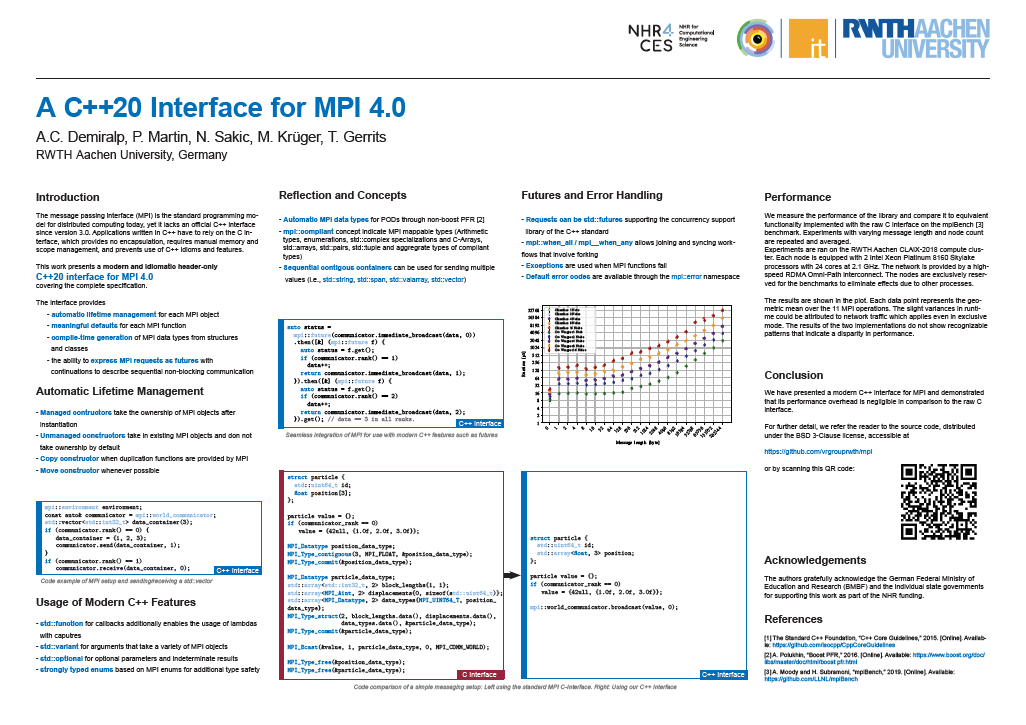
We present a modern C++20 interface for MPI 4.0. The interface utilizes recent language features to ease development of MPI applications. An aggregate reflection system enables generation of MPI data types from user-defined classes automatically. Immediate and persistent operations are mapped to futures, which can be chained to describe sequential asynchronous operations and task graphs in a concise way. This work introduces the prominent features of the interface with examples. We further measure its performance overhead with respect to the raw C interface.
@misc{demiralp2023c20,
title={A C++20 Interface for MPI 4.0},
author={Ali Can Demiralp and Philipp Martin and Niko Sakic and Marcel Krüger and Tim Gerrits},
year={2023},
eprint={2306.11840},
archivePrefix={arXiv},
primaryClass={cs.DC}
}

